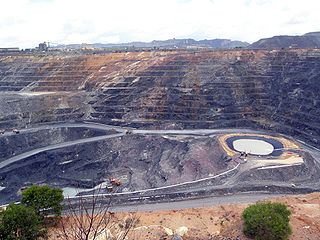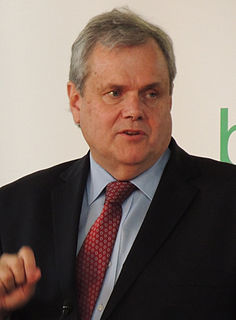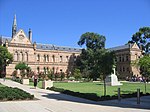
The Ranger Uranium Mine was a uranium mine in the Northern Territory of Australia. The site is surrounded by, but separate from Kakadu National Park, 230 km east of Darwin. The orebody was discovered in late 1969, and the mine commenced operation in 1980, reaching full production of uranium oxide in 1981 and ceased stockpile processing on 8 January 2021. Mining activities had ceased in 2012. It is owned and operated by Energy Resources of Australia (ERA), a public company 86.33% owned by Rio Tinto Group, the remainder held by the public. Uranium mined at Ranger was sold for use in nuclear power stations in Japan, South Korea, China, UK, France, Germany, Spain, Sweden and the United States.

Cooperative Research Centres (CRCs) are an Australian Federal Government program and are key bodies for Australian scientific research. The Cooperative Research Centres Programme was established in 1990 to enhance Australia's industrial, commercial and economic growth through the development of sustained, user-driven, cooperative public-private research centres that achieve high levels of outcomes in adoption and commercialisation. The program emphasises the importance of collaborative arrangements to maximise the benefits of research through an enhanced process of utilisation, commercialisation, and technology transfer.

Asteroid mining is the hypothetical exploitation of materials from asteroids and other minor planets, including near-Earth objects.

The National Institute of Ocean Technology (NIOT) was established in November 1993 as an autonomous society under the Ministry of Earth Sciences, Government of India. NIOT is managed by a Governing Council and the Director is the head of the Institute. The institute is based in Chennai.
Paul Holloway is an Australian politician who represented the South Australian Branch of the Australian Labor Party in the South Australian House of Assembly seat of Mitchell from 1989 to 1993, and in the South Australian Legislative Council from 1995 to 2011.
Carbon capture and storage (CCS) is a technology that can capture carbon dioxide CO2 emissions produced from fossil fuels in electricity, industrial processes which prevents CO2 from entering the atmosphere. Carbon capture and storage is also used to sequester CO2 filtered out of natural gas from certain natural gas fields. While typically the CO2 has no value after being stored, Enhanced Oil Recovery uses CO2 to increase yield from declining oil fields.

Mining in Afghanistan was controlled by the Ministry of Mines and Petroleum, prior to the August 15th takeover by the Taliban. It is headquartered in Kabul with regional offices in other parts of the country. Afghanistan has over 1,400 mineral fields, containing barite, chromite, coal, copper, gold, iron ore, lead, natural gas, petroleum, precious and semi-precious stones, salt, sulfur, lithium, talc, and zinc, among many other minerals. Gemstones include high-quality emerald, lapis lazuli, red garnet and ruby. According to a joint study by The Pentagon and the United States Geological Survey, Afghanistan has an estimated US$1 trillion of untapped minerals.

Mining is the biggest contributor to Namibia's economy in terms of revenue. It accounts for 25% of the country's income. Its contribution to the gross domestic product is also very important and makes it one of the largest economic sectors of the country. Namibia produces diamonds, uranium, copper, magnesium, zinc, silver, gold, lead, semi-precious stones and industrial minerals. The majority of revenue comes from diamond mining. In 2014, Namibia was the fourth-largest exporter of non-fuel minerals in Africa.

Mining in New Zealand began when the Māori quarried rock such as argillite in times prior to European colonisation. Mining by Europeans began in the latter half of the 19th century.
Resources are classified as either biotic or abiotic on the basis of their origin. The Indian landmass contains a multitude of both types of resource and its economy, especially in rural areas, is heavily dependent on their consumption or export. Due to overconsumption, they are rapidly being depleted.

Radioactive ores were first extracted in South Australia at Radium Hill in 1906 and Mount Painter in 1911. 2,000 tons of ore were treated to recover radium for medical use. Several hundred kilograms of uranium were also produced for use in ceramic glazes.
Peak minerals marks the point in time when the largest production of a mineral will occur in an area, with production declining in subsequent years. While most mineral resources will not be exhausted in the near future, global extraction and production has become more challenging. Miners have found ways over time to extract deeper and lower grade ores with lower production costs. More than anything else, declining average ore grades are indicative of ongoing technological shifts that have enabled inclusion of more 'complex' processing – in social and environmental terms as well as economic – and structural changes in the minerals exploration industry and these have been accompanied by significant increases in identified Mineral Reserves.

The Central Mine Planning and Design Institute is a subsidiary of Coal India Limited which is under the ownership of Ministry of Coal of the Government of India, engaged in the field of environmental engineering and provides consultancy and engineering services across the globe. It is a public sector undertaking under the Government of India and is rated as a Schedule-B and Mini Ratna-II company.

The Olympic Dam mine is a large poly-metallic underground mine located in South Australia, 550 km (340 mi) NNW of Adelaide. It is the fourth largest copper deposit and the largest known single deposit of uranium in the world. Copper is the largest contributor to total revenue, accounting for approximately 70% of the mine's revenue, with the remaining 25% from uranium, and around 5% from silver and gold. BHP has owned and operated the mine since 2005. The mine was previously owned by Western Mining Corporation.

Paul Sinclair Heithersay is a public servant employed by the Government of South Australia. He is the chief executive of the Department for Energy and Mining. He was appointed to this role by the recently elected Liberal government in June 2018.

The South Australian Chamber of Mines and Energy (SACOME) is a not-for-profit, non-government organisation founded in 1979. It represents approximately 130 companies involved in resource extraction and supporting service industries in South Australia.
Erica Lee Smyth is a Western Australian geologist, senior mining executive and chair of uranium exploration company, Toro Energy. She grew up in Geraldton, Western Australia and spent much of her early career with BHP and later Woodside Petroleum. In 2010 she received a Lifetime Achievement Award from the Western Australian Chamber of Minerals—the first of its kind for women in resources. In 2008 she received an Honorary Doctor of Letters from the University of Western Australia and in 2012 became an elected Fellow of the Australian Academy of Technological Sciences and Engineering.

South Sudan is one of the African countries known as an important oil producer, whereas, South Sudan also has mineral resources like copper, gold, diamonds, limestone among others. Government is promoting investment particularly in exploration and also developing the mining projects in South Sudan.
Prafulla Kumar Jena is an Indian metallurgist and a former director of the National Institute for Interdisciplinary Science and Technology of the Council for Scientific and Industrial Research, Bhubaneshwar. He previously held the TATA Chair for the Distinguished Professorof Metallurgical Engineering at the Indian Institute of Technology, Kharagpur. The Government of India honored him with a Padma Shri in 1977.

Geological engineering is a discipline of engineering concerned with the application of geological science and engineering principles to fields, such as civil engineering, mining, environmental engineering, and forestry, among others. The work of geological engineers often directs or supports the work of other engineering disciplines such as assessing the suitability of locations for civil engineering, environmental engineering, mining operations, and oil and gas projects by conducting geological, geoenvironmental, geophysical, and geotechnical studies. They are involved with impact studies for facilities and operations that affect surface and subsurface environments. The engineering design input and other recommendations made by geological engineers on these projects will often have a large impact on construction and operations. Geological engineers plan, design, and implement geotechnical, geological, geophysical, hydrogeological, and environmental data acquisition. This ranges from manual ground-based methods to deep drilling, to geochemical sampling, to advanced geophysical techniques and satellite surveying. Geological engineers are also concerned with the analysis of past and future ground behaviour, mapping at all scales, and ground characterization programs for specific engineering requirements. These analyses lead geological engineers to make recommendations and prepare reports which could have major effects on the foundations of construction, mining, and civil engineering projects. Some examples of projects include rock excavation, building foundation consolidation, pressure grouting, hydraulic channel erosion control, slope and fill stabilization, landslide risk assessment, groundwater monitoring, and assessment and remediation of contamination. In addition, geological engineers are included on design teams that develop solutions to surface hazards, groundwater remediation, underground and surface excavation projects, and resource management. Like mining engineers, geological engineers also conduct resource exploration campaigns, mine evaluation and feasibility assessments, and contribute to the ongoing efficiency, sustainability, and safety of active mining projects















